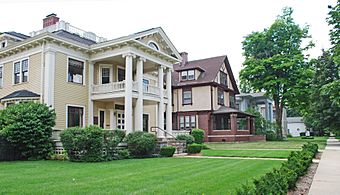South Street Historic District (Kalamazoo, Michigan) facts for kids
|
South Street Historic District
|
|
 |
|
| Location | South St. between Oakland Dr. and Westnedge Ave., W. Lovell St. from Oakland Dr. to Pearl St., and Academy St. E of Oakland, Kalamazoo, Michigan |
|---|---|
| Area | 27.9 acres (11.3 ha) |
| Architectural style | Italianate, Gothic Revival, Queen Anne |
| NRHP reference No. | 79001159 (original) 95000447 (increase) |
Quick facts for kids Significant dates |
|
| Added to NRHP | August 28, 1979 |
| Boundary increase | April 14, 1995 |
The South Street Historic District is a special neighborhood in Kalamazoo, Michigan. It's a place where many old, beautiful homes are protected because of their history. This district includes parts of South Street, West Lovell Street, and Academy Street.
It was added to the National Register of Historic Places in two parts. The first part was recognized in 1979. Later, in 1995, more of the neighborhood was added to this important list. Being on this list means the area is special and worth preserving.
Contents
History of South Street Homes
How Kalamazoo Grew
Kalamazoo started as a small settlement in 1829. The land that is now the South Street Historic District was planned out in 1839. At first, people bought plots of land just to sell them later.
Early Homes and Famous Residents
By the late 1840s, some simple homes were built in the district. These were often in the Greek Revival style. In the 1850s and 1860s, the area became a very popular and fancy place to live.
Bigger and more elegant houses appeared as wealthy families moved in. Many important people from Kalamazoo lived here in the late 1800s. These included Allen Potter, who was the first mayor of Kalamazoo. Frank B. Lay, who owned a company that made buggies, also lived in the district. Other notable residents were Oscar K. Buckhout, a local produce seller, and Albert M. Todd, who owned a large peppermint oil company.
Changes Over Time
As the 1900s continued, some new houses were built behind the larger homes. Also, some big houses were changed into two-family homes or apartments. A few newer buildings were even built as duplexes from the start.
In recent times, the neighborhood has stayed mostly the same. Very few buildings have been torn down or changed a lot. Any new homes built after 1945 fit in well with the older houses. Efforts to protect the area have helped it keep its historic look and feel.
What the District Looks Like
Original South Street Area
The first part of the South Street Historic District has 29 homes. These houses were built between the 1840s and the 1910s. They show off many different architectural styles.
You can see homes in the Greek Revival and Gothic Revival styles. There are also houses built in the Italianate, Queen Anne, Georgian Revival, and English Tudor styles. Many of these houses are large and have beautiful designs.
Expanded District Homes
The second part of the district has 87 homes. These homes also feature the same architectural styles as the original South Street houses. However, they also include styles popular in the early 1900s, like Prairie and Craftsman homes.



